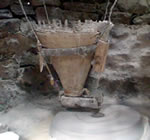Conservation of traditional crops
Cultivation of traditional crops in the recent past has been replaced by cash and horticulture crops and as a result many old varieties of millets and grains are disappearing. The age old wisdom of mixed farming i.e. 2-3 three crops sown together complemented in terms of nutrient fixation, growth, differential water requirement etc. and ensured balanced survival and thereby better food security. Some of the millets and grains are known to have natural resistance to pests and were stored for years in wooden boxes for use during crop failures. Limited market for traditional varieties combined with social denigration of old “coarse grains” and drudgery involved in dehusking millets and buckwheat is partly responsible for declining interest among farmers to continue its cultivation.
The importance of conservation of traditional crop diversity to stop soil degradation, depleting ground water table, and indiscriminate use of fertilizers and pesticides is finding wider acceptability now. It is also considered more nutritive and ecologically suitable to fragile environment regimes. The aim of the ongoing initiative has been to; a) create “niche” market for traditional crops through value added product range, thereby creating economic incentives for cultivation; b) revive social, cultural and ethno food habits based on nutritional aspect of multiple grain intake, and c) introduction of post harvest technologies to reduce drudgery involved in dehusking and grinding.
We are currently focusing on the following species:
AMARANTHUS (Amaranthus viridis)
FINGER MILLET (Eleusine coracana)
BUCKWHEAT (Fagopyrum tataricum)
FOXTAIL MILLET (Setaria Italica)
PROSO MILLET (Panicum miliaceum)
The advantages of stone-ground flour and spices are also being promoted. Local wheat, finger millet and amaranthus flour is marketed through various retail outlets in Himachal. The endosperm, bran, and germ remain in their natural, original proportions as the stones grind slowly and at lower temperatures. Heat causes the fat from the germ portion to oxidize and become rancid and much of the vitamins to be destroyed. Since only a small amount of grain is ground at a time, the fat from the germ is well distributed which also minimizes spoilage. Nutritive losses due to oxygen exposure are also limited by the fact that stone-ground flour is usually coarser.






